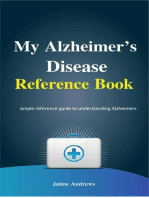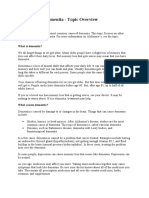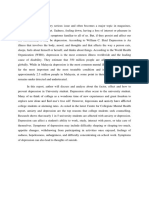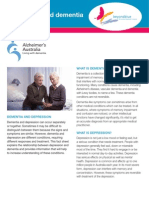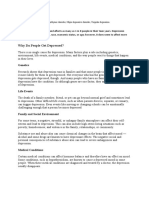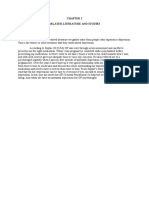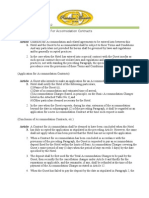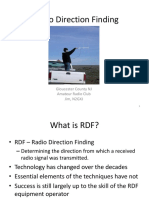0 ratings0% found this document useful (0 votes)
Rle 114
Rle 114
Uploaded by
JannetAsis1) Alzheimer's disease is a progressive brain disorder that causes the brain to shrink and brain cells to die. It is the most common cause of dementia and affects thinking, behavior, and ability to function independently.
2) Dementia is the loss of cognitive functioning such as thinking, remembering, and reasoning to the extent that it interferes with daily life. It ranges in severity and is more common in older adults but not a normal part of aging.
3) Depression is a serious medical illness that causes persistent feelings of sadness and loss of interest in activities. It has genetic, biological, environmental, and psychological causes and is treatable through therapy and medication.
Copyright:
© All Rights Reserved
Available Formats
Download as DOCX, PDF, TXT or read online from Scribd
Download as docx, pdf, or txt
Rle 114
Rle 114
Uploaded by
JannetAsis0 ratings0% found this document useful (0 votes)
1) Alzheimer's disease is a progressive brain disorder that causes the brain to shrink and brain cells to die. It is the most common cause of dementia and affects thinking, behavior, and ability to function independently.
2) Dementia is the loss of cognitive functioning such as thinking, remembering, and reasoning to the extent that it interferes with daily life. It ranges in severity and is more common in older adults but not a normal part of aging.
3) Depression is a serious medical illness that causes persistent feelings of sadness and loss of interest in activities. It has genetic, biological, environmental, and psychological causes and is treatable through therapy and medication.
Original Title
RLE 114
Copyright
© © All Rights Reserved
Available Formats
DOCX, PDF, TXT or read online from Scribd
Share this document
Did you find this document useful?
Is this content inappropriate?
1) Alzheimer's disease is a progressive brain disorder that causes the brain to shrink and brain cells to die. It is the most common cause of dementia and affects thinking, behavior, and ability to function independently.
2) Dementia is the loss of cognitive functioning such as thinking, remembering, and reasoning to the extent that it interferes with daily life. It ranges in severity and is more common in older adults but not a normal part of aging.
3) Depression is a serious medical illness that causes persistent feelings of sadness and loss of interest in activities. It has genetic, biological, environmental, and psychological causes and is treatable through therapy and medication.
Copyright:
© All Rights Reserved
Available Formats
Download as DOCX, PDF, TXT or read online from Scribd
Download as docx, pdf, or txt
0 ratings0% found this document useful (0 votes)
Rle 114
Rle 114
Uploaded by
JannetAsis1) Alzheimer's disease is a progressive brain disorder that causes the brain to shrink and brain cells to die. It is the most common cause of dementia and affects thinking, behavior, and ability to function independently.
2) Dementia is the loss of cognitive functioning such as thinking, remembering, and reasoning to the extent that it interferes with daily life. It ranges in severity and is more common in older adults but not a normal part of aging.
3) Depression is a serious medical illness that causes persistent feelings of sadness and loss of interest in activities. It has genetic, biological, environmental, and psychological causes and is treatable through therapy and medication.
Copyright:
© All Rights Reserved
Available Formats
Download as DOCX, PDF, TXT or read online from Scribd
Download as docx, pdf, or txt
You are on page 1/ 5
Name: Mark Anthony Asis Date: November 28, 2022
Year/Section: 3-B
A. Evidenced Base Practice on following Disorders:
Alzheimer’s Disease
Link: https://www.mayoclinic.org/diseases-conditions/alzheimers-disease/symptoms-
causes/syc-20350447
Alzheimer’s disease is a chronic, progressive neurologic disorder that causes the brain to
shrink at the same time the brain cells to die. It is the most common cause of the disease or
disorder dementia which is also a continuous decline in thinking, destroying your behavioral, and
social skills whereby affects the person’s daily living and the ability to function independently.
It can affect mostly in people over the age of 65. The risk of Alzheimer’s disease and
other types of dementia increases with age, affecting an estimated 1 in 14 people over the age of
65 and 1 in every 6 people over the age of 80. As the symptoms of Alzheimer's disease progress
slowly, it can be difficult to recognize that there's a problem. Many people feel that memory
problems are simply a part of getting older. The first sign of Alzheimer’s disease is usually
minor memory problems, such as forgetting about the recent conversations or events, as well as
the names of places and objects. Its symptoms develop gradually over many years and eventually
become more severe. As what I have said, it mainly affects the brain functions, thus, the presence
of symptoms that is related in our mental ability which are the confusion, disorientation and
getting lost in familiar places, difficulty in planning, or making decisions, problems with speech
and language, problems moving around without assistance or performing self-care tasks,
personality changes such as becoming aggressive, demanding and suspicious of others. An
accurate and timely diagnosis of Alzheimer's disease can give you the best chance to prepare and
plan for the future, as well as receive any treatment or support that may help. If you're worried
about your memory or think you may have dementia, it's a good idea to see a GP. There's no
single test that can be used to diagnose Alzheimer's disease. And it's important to remember that
memory problems do not necessarily mean you have Alzheimer's disease. Medications may
temporarily improve or slow progression of symptoms. These treatments can sometimes help
people with Alzheimer's disease maximize function and maintain independence for a time.
Different programs and services can help support people with Alzheimer's disease and their
caregivers. Unfortunately, there is no treatment that cures Alzheimer's disease or alters the
disease process in the brain. In advanced stages of the disease, complications from severe loss of
brain function such as dehydration, malnutrition or infection result in death.
Overall, the cause of this disorder is not clear, there is no known way to prevent the
condition, but there are things you can do that may reduce the risk or delay the onset of the
disorder, dementia and these are stopping in smoking, cutting down on alcohol, eating healthy
balance diet and maintaining a healthy weight, and staying physically fit and mentally active or
by encouraging self of doing daily activities.
Dementia
Link: https://www.webmd.com/alzheimers/types-dementia
This condition is the loss of cognitive functioning such as thinking, remembering,
and reasoning to such extent that it interferes with a person’s daily life and activities. Some
people with dementia cannot control their emotions, and their personalities may change. It ranges
in terms of its severity from the mildest stage, which is when it just begins to affect a person’s
functioning, to the most severe stage, when the person must depend completely on others for
basic activities of daily living.
It is more common on people who starts to grow older about the ages of 85 years
old or older but it is not a normal part of aging. The causes of Alzheimer’s and related dementias
can vary, depending on the types of brain changes that may be taking place. While research has
found that some changes in the brain are linked to certain forms of dementia, in most cases, the
underlying causes are unknown. Rare genetic mutations may cause dementia in a relatively small
number of people. Various disorders and factors contribute to the development of dementia
which are the age, dementia in your family, diabetes, down syndrome, multiple sclerosis, heart
disease, sleep apnea, depression, smoking, heavy alcohol use, poor diet, lack of exercise, brain
injury, strokes, and infections of the brain. Its symptoms are having a problem with thinking and
remembering that affect their ability to manage their daily life. Moreover, signs to watch or look
for when an individual is being suspected of having dementia is when he/she experience short-
term memory problems like forgetting where you put something or asking the same question
over and over, communication problems like not being able to come up with a word, getting lost,
trouble with complex but familiar tasks, and personality changes. Its diagnosis are by checking
or reviewing the blood and urine tests, chest X-ray, brain scanning (MRI or CT scanning),
Electroencephalogram (EEG), spinal fluid analysis, and also checking the attention if it is impair
or not, orientation, memory, judgment, and language, motor and cognitive functions. To treat
dementia, doctors will treat whatever is causing it. About 20% of the causes of dementia are
reversible. If the cause of a person’s dementia is not reversible, treatment will focus on managing
symptoms, particularly agitation and other emotional concerns. Although there is no proven
prevention, in general, leading a healthy lifestyle may help reduce risk factors that have been
associated with these diseases.
In conclusion, its early detection of symptoms is important, as some causes can be
treated. The confusion or forgetfulness is not temporary that might result from an infection that
heals without treatment. It can also come from an underlying illness or side effects
of medications. Dementia typically gets worse over time. Still, obtaining an early diagnosis can
help with managing the condition and planning ahead.
Depression
Link: https://www.psychiatry.org/patients-families/depression/what-is-depression
Everyone can feel sad or overwhelmed at times. But depression is a chronic
feeling of emptiness, sadness, or inability to feel pleasure that may appear to happen for no clear
reason as well as a common and serious medical illness that negatively affects your daily living.
It is distinct from grief and other emotions a person may feel following difficult life events. It
can undermine a person’s relationships, make working and maintaining good health very
difficult, and in severe cases, may lead to suicide.
It is different from sadness or grief or bereavement. The death of a loved one, loss of a
job or the ending of a relationship are difficult experiences for a person to endure. It is normal
for feelings of sadness or grief to develop in response to such situations. Those experiencing loss
often might describe themselves as being depressed. But being sad is not the same as having
depression. The grieving process is natural and unique to each individual and shares some of the
same features of depression. Both grief and depression may involve intense sadness and
withdrawal from usual activities. Depression causes feelings of sadness and/or a loss of interest
in activities you once enjoyed. It can lead to a variety of emotional and physical problems and
can decrease your ability to function at work and at home. Its causes are genetic features,
changes in brain’s neurotransmitter levels, environmental factors such as exposure to trauma or
lack of social support, psychological and social factors, and other conditions that leads to
depression like bipolar disorder. It can cause a range of psychological and physical symptoms
which are the persistent depressed mood, loss of interest or pleasure in doing hobbies and
activities, changes in appetite and body weight, unusually slow or agitated movements,
decreased energy or fatigue, difficulty sleeping, excessive feelings of guilt, difficulty making of
decisions, and the presence of thoughts of suicides or death and suicide attempts. Interactions
between various factors can increase the risk of depression like if a person with a family history
or a genetic risk of depression may experience the symptoms of depression. Fortunately, it is
treatable, though the treatment may depend on the exact type a person is living with. Its
treatment is usually managing the symptoms by supporting the patient in a way of discussing
practical solutions and educating the family of the patient, psychotherapy or talking therapy, and
drug treatment such as antidepressants. To decrease or reduce the probability of the person in
engaging an activity that is related to suicidal attempts.
To conclude, Depression is a serious, chronic medical condition that can affect every
aspect of a person’s life. When it causes suicidal thoughts, it can be fatal. People cannot think
their way out of depression. Depression is not a personal failing or a sign of weakness. It is
treatable, and seeking treatment early may increase the chances of recovery. Since, depression
can be challenging to treat, it is important for a person to see a doctor with expertise in
depression and to be willing to try several different treatments. Often, a combination of therapy
and medication offers the best results.
Fall (Injury)
Link: https://www.ncbi.nlm.nih.gov/books/NBK2653/
It is defined as an event which results in a person coming to rest inadvertently on the
ground or floor or other lower level. Falls are a common, but often overlooked, cause of injury.
In fact, around 1 in 3 adults over 65 and half of people over 80 will have at least one fall a year.
Most falls do not result in serious injury. But there's always a risk that a fall could lead to broken
bones, and it can cause the person to lose confidence, become withdrawn, and feel as if they have
lost their independence.
Falls are a marker of frailty, immobility, and acute and chronic health impairment in
older persons. Falls in turn diminish function by causing injury, activity limitations, fear of
falling, and loss of mobility. Most injuries in the elderly are the result of falls such as fractures of
the hip, forearm, back, and pelvis usually result from the combined effect of falls and
osteoporosis. Falls may be precipitated by intrinsic or extrinsic factors. Intrinsic factors are those
that have a physiologic origin, and extrinsic factors are those precipitating from environmental or
other hazards. If you or the person experiencing fall in any instances, it's important to keep calm.
If you're not hurt and you feel strong enough to get up, do not get up quickly. Roll onto your
hands and knees and look for a stable piece of furniture, such as a chair or bed. Hold on to the
furniture with both hands to support yourself and, when you feel ready, slowly get up. Sit down
and rest for a while before carrying on with your daily activities. While all people who fall are at
risk of injury, the age, gender and health of the individual can affect the type and severity of
injury. Its prevention varies on how the person distinguish and perceive the hazard such as by
fixing the environment in a way of putting away the things that can lead the person to fall,
restricting access to dangerous area especially the older people, promote policies and playground
standards requiring soft play surfaces and restricted fall heights, home assessment and
modification to reduce the possibility of getting the older people experience fall, and supporting
or providing a helping hand to the elderly when they are going to walk or go to other places. The
success of preventive efforts may depend on the ability to target interventions toward those risk
factors that are most important in subgroups of the population. Medical and rehabilitative
approaches may be most beneficial in the very impaired elderly and those, living in nursing
homes, whereas environmental and behavioral interventions may have most value among healthy
older persons living in the community. Nevertheless, these contrasting approaches may only
imply different emphases on a common set of factors, with intrinsic, environmental, and
situational factors combining to cause most falls in both healthy and impaired persons.
To sum it up, fall is an unintentional event that results in the person lying or coming rest
on the ground or another lower level. It threatens the independence of older people and can cause
a cascade of individual and socioeconomic consequences. That is why, the goal of prevention in
terms of fall or falling should be not only to reduce falls but to reduce injury and other sequelae
of falls. The risk of injury from a fall is the product of a sequence of risks, including the
probability of falling, the effectiveness of protective responses, protection by local shock
absorbers, including environmental surfaces, and the strength and resiliency of tissue and organs.
Thus, preventive efforts should address each of the phases in the injury sequence
You might also like
- Agreement To Demolish/Remove and Reconstruct Improvement (Adri)100% (1)Agreement To Demolish/Remove and Reconstruct Improvement (Adri)3 pages
- Depression in Older Adults (Problem Tree Analysis)No ratings yetDepression in Older Adults (Problem Tree Analysis)8 pages
- Dementia, Alzhiemrs Diseaseand Geriatric DiseaseNo ratings yetDementia, Alzhiemrs Diseaseand Geriatric Disease12 pages
- Agepage: Forgetfulness: Knowing When To Ask For HelpNo ratings yetAgepage: Forgetfulness: Knowing When To Ask For Help12 pages
- Dementia - Symptoms: Dementia Area of The Brain DementiaNo ratings yetDementia - Symptoms: Dementia Area of The Brain Dementia17 pages
- Modern Anti Depression Management, Recovery, Solutions and Treatment: A Guidebook for healing, mindfulness & understanding depression in relationships, men & women, husbands, teenagers, kids, etc.From EverandModern Anti Depression Management, Recovery, Solutions and Treatment: A Guidebook for healing, mindfulness & understanding depression in relationships, men & women, husbands, teenagers, kids, etc.No ratings yet
- Dementia caregiver guide: The Secret I Used to Love Someone With Cognitive Decline (Empowering Tips To Eliminate Burnout, Reduce Stress and Strengthen Relationships)From EverandDementia caregiver guide: The Secret I Used to Love Someone With Cognitive Decline (Empowering Tips To Eliminate Burnout, Reduce Stress and Strengthen Relationships)No ratings yet
- Dementia - Topic Overview: Is This Topic For You?No ratings yetDementia - Topic Overview: Is This Topic For You?3 pages
- Dementia Demystified: A Comprehensive Guide to Understanding, Managing, and Preventing Cognitive Decline: The NeuroHealth Collection: Understanding Diseases of the Nervous System, #16From EverandDementia Demystified: A Comprehensive Guide to Understanding, Managing, and Preventing Cognitive Decline: The NeuroHealth Collection: Understanding Diseases of the Nervous System, #16No ratings yet
- Depression in Older Adults: The Expert Consensus Guideline Series100% (1)Depression in Older Adults: The Expert Consensus Guideline Series12 pages
- The alzheimer's caregiver & families guide: Coping with alzheimers disease, through the stages, including prevention, diet, safety to conventional & alternative healthcare optionsFrom EverandThe alzheimer's caregiver & families guide: Coping with alzheimers disease, through the stages, including prevention, diet, safety to conventional & alternative healthcare optionsNo ratings yet
- The Dark Side of the Mind Understanding and Coping with DepressionFrom EverandThe Dark Side of the Mind Understanding and Coping with DepressionNo ratings yet
- UNIT 533 Understand The Process and Experience of Dementia: 1.1 Describe A Range of Causes of Dementia Syndrome?No ratings yetUNIT 533 Understand The Process and Experience of Dementia: 1.1 Describe A Range of Causes of Dementia Syndrome?9 pages
- Depression: Why Do People Get Depressed?No ratings yetDepression: Why Do People Get Depressed?3 pages
- Kick Out Depression and Fly: How to Get Rid of Depression and Anxiety with EaseFrom EverandKick Out Depression and Fly: How to Get Rid of Depression and Anxiety with Ease4.5/5 (6)
- Performance Task in Personal Development (Depression) : Submitted By: Submitted To100% (1)Performance Task in Personal Development (Depression) : Submitted By: Submitted To6 pages
- Done By: Mostafa Grade: 10B Bio Teacher: Mr. Kamel: What Is Alzheimer's Disease?No ratings yetDone By: Mostafa Grade: 10B Bio Teacher: Mr. Kamel: What Is Alzheimer's Disease?18 pages
- Alzheimers Dementia About Alzheimers Disease TsNo ratings yetAlzheimers Dementia About Alzheimers Disease Ts12 pages
- The Increasing of The Depression in The AdolescenceNo ratings yetThe Increasing of The Depression in The Adolescence10 pages
- Dementia:: Find A Counsellor or Psychotherapist Dealing With DementiaNo ratings yetDementia:: Find A Counsellor or Psychotherapist Dealing With Dementia4 pages
- UGC-CARE List of Journals For MultidisciplinaryNo ratings yetUGC-CARE List of Journals For Multidisciplinary3 pages
- Meeting Schedule & WTA Schedule On Safety & QualityNo ratings yetMeeting Schedule & WTA Schedule On Safety & Quality2 pages
- Gerona Vs Secretary Administrative Case VS: You've Visited This Page 2 Times. Last Visit: 7/13/18No ratings yetGerona Vs Secretary Administrative Case VS: You've Visited This Page 2 Times. Last Visit: 7/13/182 pages
- Terms and Conditions For Accomodation ContractsNo ratings yetTerms and Conditions For Accomodation Contracts6 pages
- My Family at Home: Read The Text and Answer The QuestionsNo ratings yetMy Family at Home: Read The Text and Answer The Questions3 pages
- Exploration of TCP Parameters For Enhanced Performance in A Datacenter EnvironmentNo ratings yetExploration of TCP Parameters For Enhanced Performance in A Datacenter Environment5 pages
- Basic Concepts and Principles in AssessmentNo ratings yetBasic Concepts and Principles in Assessment49 pages
- Small Arms & Ammunition: Vol 29 - Issue 5 - October 2021 - ISSN No. 0971 - 4413 WWW - Drdo.gov - inNo ratings yetSmall Arms & Ammunition: Vol 29 - Issue 5 - October 2021 - ISSN No. 0971 - 4413 WWW - Drdo.gov - in16 pages
- Franz Schubert and His Times - Kobald, Karl, 1876 - Marshall, Beatrice, TR - 1970 - Port Washington, N.Y., Kennikat Press - 9780804607568 - Anna's ArchiveNo ratings yetFranz Schubert and His Times - Kobald, Karl, 1876 - Marshall, Beatrice, TR - 1970 - Port Washington, N.Y., Kennikat Press - 9780804607568 - Anna's Archive328 pages
- LPTv4 Module 44 Penetration Testing Report AnalysisNo ratings yetLPTv4 Module 44 Penetration Testing Report Analysis12 pages
- The Strategy For Huawei Going Global Huawei's Initial Market Strategy For Entering The European MarketNo ratings yetThe Strategy For Huawei Going Global Huawei's Initial Market Strategy For Entering The European Market7 pages
- Agreement To Demolish/Remove and Reconstruct Improvement (Adri)Agreement To Demolish/Remove and Reconstruct Improvement (Adri)
- Depression in Older Adults (Problem Tree Analysis)Depression in Older Adults (Problem Tree Analysis)
- Agepage: Forgetfulness: Knowing When To Ask For HelpAgepage: Forgetfulness: Knowing When To Ask For Help
- My Alzheimer's Disease Reference Book: Reference Books, #3From EverandMy Alzheimer's Disease Reference Book: Reference Books, #3
- Minds Fading Away : Alzheimer's And Dementia GuideFrom EverandMinds Fading Away : Alzheimer's And Dementia Guide
- Dementia - Symptoms: Dementia Area of The Brain DementiaDementia - Symptoms: Dementia Area of The Brain Dementia
- Modern Anti Depression Management, Recovery, Solutions and Treatment: A Guidebook for healing, mindfulness & understanding depression in relationships, men & women, husbands, teenagers, kids, etc.From EverandModern Anti Depression Management, Recovery, Solutions and Treatment: A Guidebook for healing, mindfulness & understanding depression in relationships, men & women, husbands, teenagers, kids, etc.
- Dementia caregiver guide: The Secret I Used to Love Someone With Cognitive Decline (Empowering Tips To Eliminate Burnout, Reduce Stress and Strengthen Relationships)From EverandDementia caregiver guide: The Secret I Used to Love Someone With Cognitive Decline (Empowering Tips To Eliminate Burnout, Reduce Stress and Strengthen Relationships)
- Dementia Demystified: A Comprehensive Guide to Understanding, Managing, and Preventing Cognitive Decline: The NeuroHealth Collection: Understanding Diseases of the Nervous System, #16From EverandDementia Demystified: A Comprehensive Guide to Understanding, Managing, and Preventing Cognitive Decline: The NeuroHealth Collection: Understanding Diseases of the Nervous System, #16
- Depression in Older Adults: The Expert Consensus Guideline SeriesDepression in Older Adults: The Expert Consensus Guideline Series
- The alzheimer's caregiver & families guide: Coping with alzheimers disease, through the stages, including prevention, diet, safety to conventional & alternative healthcare optionsFrom EverandThe alzheimer's caregiver & families guide: Coping with alzheimers disease, through the stages, including prevention, diet, safety to conventional & alternative healthcare options
- The Dark Side of the Mind Understanding and Coping with DepressionFrom EverandThe Dark Side of the Mind Understanding and Coping with Depression
- UNIT 533 Understand The Process and Experience of Dementia: 1.1 Describe A Range of Causes of Dementia Syndrome?UNIT 533 Understand The Process and Experience of Dementia: 1.1 Describe A Range of Causes of Dementia Syndrome?
- Kick Out Depression and Fly: How to Get Rid of Depression and Anxiety with EaseFrom EverandKick Out Depression and Fly: How to Get Rid of Depression and Anxiety with Ease
- How To Overcome Depression With The Power Of ThoughtsFrom EverandHow To Overcome Depression With The Power Of Thoughts
- Performance Task in Personal Development (Depression) : Submitted By: Submitted ToPerformance Task in Personal Development (Depression) : Submitted By: Submitted To
- Done By: Mostafa Grade: 10B Bio Teacher: Mr. Kamel: What Is Alzheimer's Disease?Done By: Mostafa Grade: 10B Bio Teacher: Mr. Kamel: What Is Alzheimer's Disease?
- Overcoming Depression: A Mental Guide to Hope and HappinessFrom EverandOvercoming Depression: A Mental Guide to Hope and Happiness
- The Increasing of The Depression in The AdolescenceThe Increasing of The Depression in The Adolescence
- Dementia:: Find A Counsellor or Psychotherapist Dealing With DementiaDementia:: Find A Counsellor or Psychotherapist Dealing With Dementia
- Meeting Schedule & WTA Schedule On Safety & QualityMeeting Schedule & WTA Schedule On Safety & Quality
- Gerona Vs Secretary Administrative Case VS: You've Visited This Page 2 Times. Last Visit: 7/13/18Gerona Vs Secretary Administrative Case VS: You've Visited This Page 2 Times. Last Visit: 7/13/18
- My Family at Home: Read The Text and Answer The QuestionsMy Family at Home: Read The Text and Answer The Questions
- Exploration of TCP Parameters For Enhanced Performance in A Datacenter EnvironmentExploration of TCP Parameters For Enhanced Performance in A Datacenter Environment
- Small Arms & Ammunition: Vol 29 - Issue 5 - October 2021 - ISSN No. 0971 - 4413 WWW - Drdo.gov - inSmall Arms & Ammunition: Vol 29 - Issue 5 - October 2021 - ISSN No. 0971 - 4413 WWW - Drdo.gov - in
- Franz Schubert and His Times - Kobald, Karl, 1876 - Marshall, Beatrice, TR - 1970 - Port Washington, N.Y., Kennikat Press - 9780804607568 - Anna's ArchiveFranz Schubert and His Times - Kobald, Karl, 1876 - Marshall, Beatrice, TR - 1970 - Port Washington, N.Y., Kennikat Press - 9780804607568 - Anna's Archive
- LPTv4 Module 44 Penetration Testing Report AnalysisLPTv4 Module 44 Penetration Testing Report Analysis
- The Strategy For Huawei Going Global Huawei's Initial Market Strategy For Entering The European MarketThe Strategy For Huawei Going Global Huawei's Initial Market Strategy For Entering The European Market














